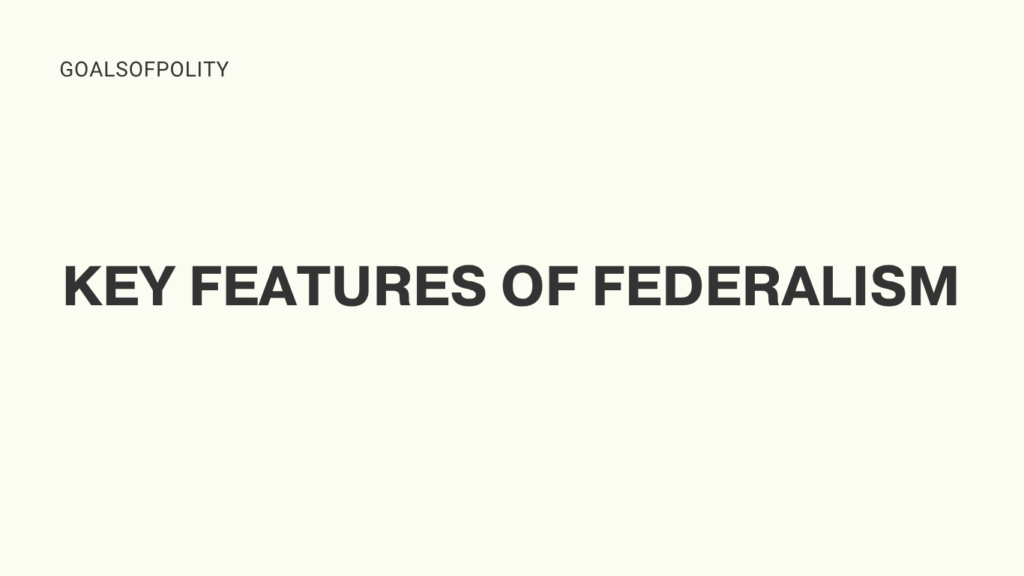Table of Contents
Introduction:
Federalism in India is the cornerstone of the nation’s governance structure, providing a framework for the distribution of power between the central government and the states. It reflects the diversity and complexity of India’s socio-political landscape, aiming to accommodate regional aspirations while maintaining national unity. Over the years, Indian federalism has evolved, keeping pace with changing dynamics and addressing emerging challenges.
Key Features of Federalism:

Indian federalism has several key features, including distribution of powers, division of responsibilities, and a bicameral legislature at both the central and state levels. The Constitution also provides mechanisms such as the Inter-State Council to resolve disputes and promote cooperative federalism.
Evolution of Federalism in India: India adopted a federal system after independence in 1947, as enshrined in the Constitution. However, the nature and dynamics of federalism have undergone significant changes since then. Initially, the federal structure was inclined towards centralization, with a greater focus on nation-building and integration. The central government often wielded considerable power at the expense of state autonomy.
Reforms and Amendments:
Several constitutional amendments have been made in the last few years to strengthen federalism. The Sarkaria Commission and the Punchhi Commission provided recommendations to improve center-state relations and address fiscal disparities among states.
Recent Trends in Indian Federalism: In recent years, several noteworthy trends have emerged, reshaping the contours of federalism:
- Devolution of Powers: A major trend is the increasing devolution of powers to the states. Recognizing the importance of decentralization and empowering local governments, successive governments have taken measures to devolve authority and resources to the states. Initiatives such as the implementation of the Goods and Services Tax (GST) and the recommendations of various Finance Commissions aim to enhance fiscal autonomy and strengthen federal principles.
- Cooperative Federalism: Another important trend is the emphasis on cooperative federalism, which emphasizes cooperation and coordination between the central and state governments. This approach seeks to foster a spirit of partnership and mutual respect, enabling effective policy implementation and governance. Platforms such as NITI Aayog serve as platforms for dialogue and consensus building among stakeholders, promoting cooperative decision-making and collective action.
- Regional Aspirations: he resurgence of regional aspirations has also influenced federalism. With the rise of regional parties and demands for greater autonomy, there is growing recognition of the diversity of India’s states and the need to accommodate their distinct identities and concerns. Issues such as language, culture, resource distribution have fuelled debates on asymmetrical federalism and demands for special status.
Implications for the Democratic Process: The evolving dynamics of federalism have important implications for the democratic process in the country:
- Increased Participation: By decentralizing power and promoting cooperative governance, federalism encourages greater participation and representation, allowing diverse voices to be heard in the decision-making process.
- Responsive Governance: Devolution of powers to the states allows for more responsive and context-sensitive governance, as states can tailor policies to local needs and priorities, thus promoting effective service delivery and development outcomes.
- Balancing Centralization and Autonomy: Striking a balance between centralization and state autonomy remains an enduring challenge in federalism. While a strong center is essential for national cohesion and integration, excessive centralization can undermine the principles of federalism and impede democratic accountability.
- Conflict Resolution Mechanisms: The existence of strong conflict resolution mechanisms, including constitutional provisions and judicial intervention, helps to mitigate tensions between the center and states, ensure the smooth functioning of the federal system, and maintain democratic norms.
Challenges to Indian Federalism:
Despite its strengths, federalism faces several challenges. Regional disparities in development, inter-state conflicts over resources, and political interference in state affairs pose significant obstacles to effective governance and cooperative federalism.
Future Prospects and Recommendations:
To address these challenges, there is a need for greater dialogue and cooperation between the central government and the states. Strengthening institutions such as the Inter-State Council, promoting fiscal federalism, and addressing regional imbalances are essential for the sustainable development of federalism.
Conclusion:
In conclusion, recent trends in Indian federalism reflect a dynamic and evolving landscape, involving efforts to reconcile competing interests and accommodate diverse aspirations. While challenges persist, federalism remains an important instrument for promoting democracy, pluralism, and inclusive growth. By adopting the principles of devolution, cooperation, accommodation, India can continue to strengthen its federal structure and uphold the democratic ideals enshrined in its Constitution.
FAQs:
1. What is the significance of federalism in India?
Federalism in India ensures a balance of power between the central government and the states, which accommodates the country’s diverse cultural, linguistic, and regional identities.
2. How has GST affected Indian federalism?
The implementation of GST has streamlined tax administration, reduced interstate trade barriers, and promoted cooperative federalism by pooling resources for common welfare programs.
3. What are some of the challenges to Indian federalism?
Challenges to Indian federalism include regional disparities in development, inter-state conflicts over resources, and political interference in state affairs.
4. What recommendations can strengthen federalism?
Strengthening institutions such as the Inter-State Council, promoting fiscal federalism, and addressing regional imbalances are essential for the sustainable development of Indian federalism.
5. What is the future outlook for Indian federalism?
Despite the challenges, Indian federalism has shown resilience and adaptability. With concerted efforts towards cooperative governance and inclusive growth, Indian federalism can evolve and flourish.

